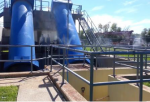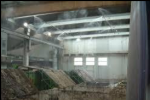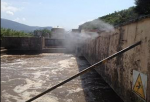Nebulisation of De-Odorising/ Masking Products
Another quite common solution for the reduction of odour emissions, which can be applied both to conveyed and to diffuse sources, is the nebulisation of de-odorising or masking products.
In the case of conveyed emissions, the nebulising nozzles can be installed directly at the stack outlet, with the aim of reducing the odour concentration of the emitted air flow. In the case of diffuse emissions, such as wastewater treatment tanks, composting piles or landfills, the nebulisation of the de-odorising product can be realised with the purpose of creating a sort of “osmogenic barrier” for the abatement of the odours that diffuse into the atmosphere.
Nebulisation can also be implemented inside sheds (for instance, sheds for the receiving / treatment of solid wastes). Some examples of applications are illustrated in Figure 1 to Figure 3.
Such de-odorising products usually have their own, pleasant odour (typically fresh/ pine/ citrus due to the presence of terpenic compounds) and are usually diluted at low (or very low) concentrations in water.
Indeed, the dosing of the de-odorising product is critical in order to avoid the emission of odours due to the deodorising product itself: this is usually less unpleasant than the odour to be treated, but if the concentration is high, then it might still become a source of odour nuisance. This is one of the main reasons why preliminary tests are required in order to optimise the application for the specific case.
In the case of conveyed emissions, the nebulising nozzles can be installed directly at the stack outlet, with the aim of reducing the odour concentration of the emitted air flow. In the case of diffuse emissions, such as wastewater treatment tanks, composting piles or landfills, the nebulisation of the de-odorising product can be realised with the purpose of creating a sort of “osmogenic barrier” for the abatement of the odours that diffuse into the atmosphere.
Nebulisation can also be implemented inside sheds (for instance, sheds for the receiving / treatment of solid wastes). Some examples of applications are illustrated in Figure 1 to Figure 3.
Such de-odorising products usually have their own, pleasant odour (typically fresh/ pine/ citrus due to the presence of terpenic compounds) and are usually diluted at low (or very low) concentrations in water.
Indeed, the dosing of the de-odorising product is critical in order to avoid the emission of odours due to the deodorising product itself: this is usually less unpleasant than the odour to be treated, but if the concentration is high, then it might still become a source of odour nuisance. This is one of the main reasons why preliminary tests are required in order to optimise the application for the specific case.
- Figure 1. Example of nebulisation of de-odorising products for odour abatement
- Figure 2. Example of nebulisation of de-odorising products for odour abatement
- Figure 3. Example of nebulisation of de-odorising products for odour abatement
However, verification of the efficiency of the abatement, especially in the case of diffuse emissions is hardly applicable, thus requiring specific experimental setups (Dentoni et al., 2012) or field odour measurement campaigns.
Despite very appealing declarations about the capability of neutralising odours that can be found on commercial material (i.e. websites and brochures), the functioning principle of such de-odorising is not really understood. Some producers declare the presence of microorganisms that biologically degrade the odour, others of encapsulating molecules that “trap” the odorous molecules making them inoffensive. As already mentioned, since de-odorising products are usually used diluted, the presence of the water surely has a scrubbing effect that adds to the reduction of the odour emissions, at least for hydrophilic odorous compounds. However, there are some examples, where the application of such products has been proven to be effective in reducing the odour perception outside the plant and the frequency of complaints (Culos et al., 2009).
This solution has the advantage of having low investment costs. The degree of the operational costs may be significant, depending on the cost and on the quantity of the nebulised product.
Despite very appealing declarations about the capability of neutralising odours that can be found on commercial material (i.e. websites and brochures), the functioning principle of such de-odorising is not really understood. Some producers declare the presence of microorganisms that biologically degrade the odour, others of encapsulating molecules that “trap” the odorous molecules making them inoffensive. As already mentioned, since de-odorising products are usually used diluted, the presence of the water surely has a scrubbing effect that adds to the reduction of the odour emissions, at least for hydrophilic odorous compounds. However, there are some examples, where the application of such products has been proven to be effective in reducing the odour perception outside the plant and the frequency of complaints (Culos et al., 2009).
This solution has the advantage of having low investment costs. The degree of the operational costs may be significant, depending on the cost and on the quantity of the nebulised product.
References
Culos, B., Rivilli, S., Snidar, R., Capelli, L., Sironi, S., Trovarelli, A. (2009). The application of electronic noses in the evaluation of efficiency of neutralizing products for odour abatement in landfills. In: Proceedings of Sardinia 2009, R. Cossu, L.F. Diaz, R. Stegmann (Eds.), Twelfth International Waste Management and Landfill Symposium, 5-9 October 2009, S. Margherita di Pula, Cagliari, Italy, CISA Publisher (ISBN: 978-88-6265-007-6).Dentoni, L., Bascelli, M., Capelli, L., Sironi, S., Del Rosso, R., Buccolini, M. (2012). Design of a specific apparatus to evaluate odour reduction efficiency of a nebulizing system applied on odorous liquid surfaces. Chemical Engineering Transactions 30, 289-294. https://www.aidic.it/cet/12/30/049.pdf



